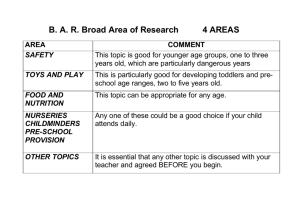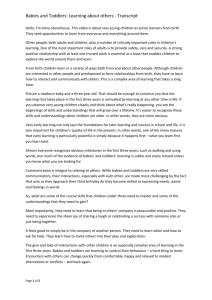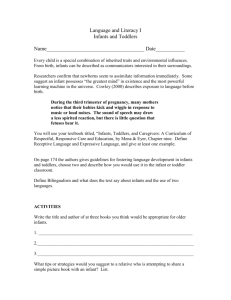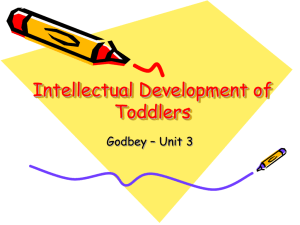Document
advertisement
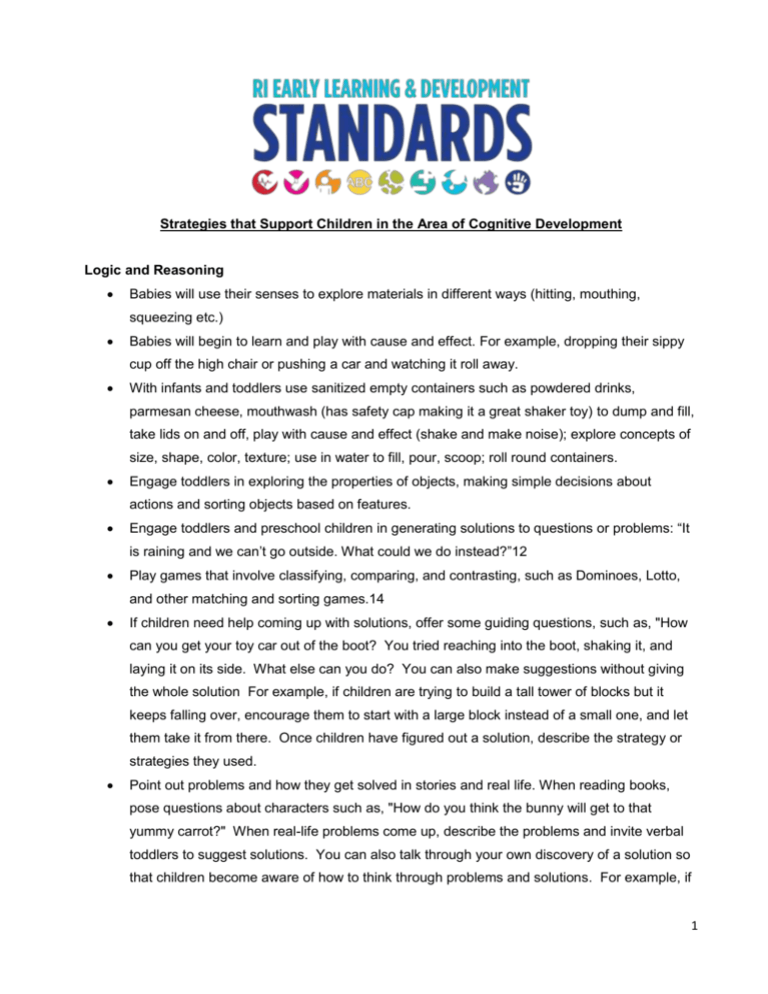
Strategies that Support Children in the Area of Cognitive Development Logic and Reasoning Babies will use their senses to explore materials in different ways (hitting, mouthing, squeezing etc.) Babies will begin to learn and play with cause and effect. For example, dropping their sippy cup off the high chair or pushing a car and watching it roll away. With infants and toddlers use sanitized empty containers such as powdered drinks, parmesan cheese, mouthwash (has safety cap making it a great shaker toy) to dump and fill, take lids on and off, play with cause and effect (shake and make noise); explore concepts of size, shape, color, texture; use in water to fill, pour, scoop; roll round containers. Engage toddlers in exploring the properties of objects, making simple decisions about actions and sorting objects based on features. Engage toddlers and preschool children in generating solutions to questions or problems: “It is raining and we can’t go outside. What could we do instead?”12 Play games that involve classifying, comparing, and contrasting, such as Dominoes, Lotto, and other matching and sorting games.14 If children need help coming up with solutions, offer some guiding questions, such as, "How can you get your toy car out of the boot? You tried reaching into the boot, shaking it, and laying it on its side. What else can you do? You can also make suggestions without giving the whole solution For example, if children are trying to build a tall tower of blocks but it keeps falling over, encourage them to start with a large block instead of a small one, and let them take it from there. Once children have figured out a solution, describe the strategy or strategies they used. Point out problems and how they get solved in stories and real life. When reading books, pose questions about characters such as, "How do you think the bunny will get to that yummy carrot?" When real-life problems come up, describe the problems and invite verbal toddlers to suggest solutions. You can also talk through your own discovery of a solution so that children become aware of how to think through problems and solutions. For example, if 1 you have more children than crackers for snack time, you might say, "Oh no, we have eight children and only seven crackers left. That's not enough crackers! What can we do? Maybe instead of crackers for snack today, we can have sliced cucumbers." Memory and Working Memory Babies will begin to respond to familiar people. Babies will begin to remember that objects and people are still there even when unseen. When babies develop what is called “object permanence” encourage them to find easy to gather objects, for example a baby doll that is covered by a blanket. Play simple games from home and school, such as peek-a-boo and hide-and-seek with partially hidden favorite toys. For older toddlers, try "hide Teddy" (hiding a teddy bear in predictable places around the room and inviting the child to find it) and the Memory Game, using a few sets of matching pictures. Talk about events that happened earlier in the day, the day before, or even "a long time ago." Infants and toddlers may not have a concrete sense of time but are often surprisingly good at remembering what happened before. Use photos of children, their families, and familiar objects to talk about children's past experiences. This will help to create and keep memories. Help toddlers and preschoolers find objects which are kept in familiar places, for example their cubbies. Keep materials in the home, classroom, or family child care home consistent. While it is always a good idea to rotate out materials as children lose interest in them, it is also helpful to offer the same materials in the same location for an extended period of time. For example, a block area might always have the same set of wooden blocks, people, and vehicles. For variety, you might add animals, balls, or empty boxes but still keep the usual items on the shelf. Provide opportunities for toddlers and preschoolers to follow short two and three step directions. For example, wash your hands and then have a seat at the table. Use visual comparisons of things in daily routines, ex. “Which pile has more?” During play, separate objects by features, for example color, shape or size. Use every day experiences to analyze the results of attempted solutions to solving problems. Use every day opportunities to explain the reasoning behind your choices. As adults you can model this! Create rituals around routines; it can help children remember what will happen next. 2 Create and maintain a daily schedule for older infants, toddlers and preschoolers. Make sure that each day follows a similar pattern. The same things do not need to happen at the same time every day, but if they happen in the same order, children will soon remember what came before and what happens next. A very simple picture schedule helps as a visual reminder of the daily routines. Attention and Inhibitory Control Give young infants one or two toys or materials at a time to play with. Switch the toys/ materials with something different when you notice children losing interest. As they get older, rotate indoor and outdoor toys and materials more regularly to maintain children's interest; provide new ones that build on those already familiar to the children, such as wind chimes, wind socks, flags that move in the wind, bird feeders, and new photos of family members. Babies will begin to develop the ability to pause when an adult says “wait”. Maintain a calm attitude and presence. Infants are "tuned in" to adults' emotions; your calmness can help infants manage strong emotions, especially when they are not calm. Identify, acknowledge, and support self-soothing behaviors. Anticipate infants' needs and respond as soon as you can. If you can't get to a child quickly, use your words to let the child know you've heard him. Describe the child's feelings, what you are doing, and what will happen next in a soothing manner. Support transitions between different parts of the daily schedule by preparing them for the transition: "After we go inside, we'll have a snack." Give toddlers simple but valid choices: "You may have apple slices or orange slices." Provide children with space, time, and a variety of interesting, culturally- and age-appropriate toys and materials to explore. Allow them to use toys and materials in their own ways and to repeat actions and activities. Play simple games from home and school that involve repetition, such as peek-a-boo. Observe! Notice what toys, experiences, people, and interactions maintain or increase their interest. Describe what children see, hear, and do. For toddlers, interpret and expand on what they do and say. Ask open-ended questions, such as "How did you do that. Tell me more." With close supervision, allow children time to work through their emotions. Give them words to express their feelings. Comment on toddlers' attempts to handle a challenging situation: "Jasiah took the pail from you. You didn't take it back from her. You used a different pail. That was a kind way to solve 3 the pail problem." For older toddlers, you might provide verbal guidance: “There are only two watering cans. But three children want to water our vegetable garden. What can we do about this?" Children are learning to attend for longer and longer periods of time. A baby or toddler may only want you to read one or two pages in a book. Preschoolers should with increasing ability be able to listen to a full story. Use every day opportunities to talk about the passing of time for example by using words such as “now” and “later”. As children grow you can provide simple directions, ex. “please put this in your cubby”. During block play build in details such as bridges and arches. Allow opportunities for activities that can be continued at a later time, for example, building with blocks, sticks and Styrofoam. Cognitive Flexibility Step back and let infants and toddlers try things their own way. Letting children attempt, fail, and even become a little frustrated allows children to eventually gain the understanding that it is okay to try and fail. They might find that frustration can be a good motivator to try a different approach. This helps children develop the ability to handle stressful situations and still function effectively. Recognize that children have different levels of tolerance for frustration. Some children are frustrated with one failed attempt, while others seem able to persist no matter what. When you offer help, individualize your response and how much help you offer so that you are meeting children's needs and helping them get just a bit further. Engage children in generating multiple solutions to questions or problems: “It is raining and we can’t go outside. What could we do instead?” When exploring or experimenting with a science or math topic, engage children in the scientific method of asking questions, generating hypotheses, gathering data, predicting what will happen, and observing consequences. Play games that involve classifying, comparing, and contrasting, such as Dominoes, Lotto, and other matching and sorting games. Ask children to classify objects using more than one attribute (“Find the large, blue square; find the small, red circle.”). Help children verbalize their reasoning, thinking out loud about how to solve a problem or answer a question. Write down children’s recommended ways of solving problems as well as their solutions to problems. Try them out. 4 Model open-mindedness and creativity. Demonstrate that there may be more than one way to do things or to solve problems. Encourage children to think of as many solutions as they can to interpersonal problem situations. Ask them to think about what would happen next if they a used a certain solution or to anticipate the consequences of an action. Read and act out stories in which characters reason and solve challenging problems. The Head Start Leader’s Guide 5

